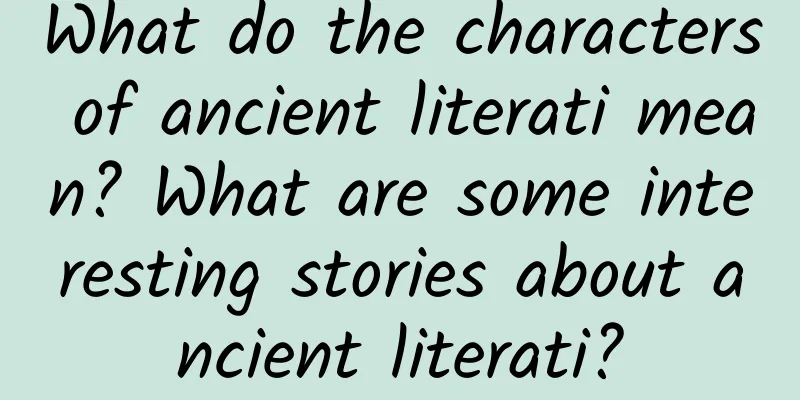What do the characters of ancient literati mean? What are some interesting stories about ancient literati?

|
Our ancient literati actually paid more attention to the harmony between people and society. They never talked about harmony from the outside of things, but more from the relationship between people and politics, people and materials, people and nature, people and society. Harmony is the ideal society they pursue, and it is also the highest spiritual realm that these literati pursue throughout their lives. So what do the characters of ancient literati mean? What are some interesting stories about ancient literati? Let's take a look at the introduction of Encyclopedia Knowledge Network! Contents of this article 1. What do the characters of ancient literati mean? 2. What are some interesting stories about ancient literati? 3. What are the four great things of ancient literati? 4. Why did ancient scholars hold a fan? 1What do the characters of ancient literati mean?The word "zi" represents virtue and was only used by people of status in ancient times. The Book of Rites states that a man is given a courtesy name when he reaches the age of 20, and a woman is given a courtesy name when she reaches the age of 15. This means that no matter whether a man or a woman is an adult, they are given a courtesy name in order to gain respect and to be addressed by others. Ordinary people, especially peers and subordinates, are only allowed to address elders by their courtesy names and not by their names. 2What are some interesting stories about ancient literati?1. Bare-bellied East Bed: It refers to the high official Xi Jian who went to Prime Minister Wang Dao's house to select a son-in-law. He saw that among all the people, only Wang Xizhi didn't care at all, lying on the floor bed in dishevel to eat. He felt that Wang Xizhi was free and easy and generous, so he decided to marry his daughter to him. 2. Zhu Yuanzhang and Persimmon Trees: According to "Yanjing Food Records", Zhu Yuanzhang, the founding emperor of the Ming Dynasty, was poor when he was young and often went hungry and ate persimmons. After he became emperor, he remembered the contribution of persimmon trees, planted trees, and ordered the people to plant persimmons, peaches, and dates. Persimmon trees were widely planted in Anhui and other places. 3. Dong Feng and the Apricot Forest: Dong Feng, a famous doctor in Wu during the Three Kingdoms period, was a skilled doctor who was kind and generous. During his seclusion in Mount Lu, Dong Feng treated poor people for free, and the people planted apricot trees in return. Those with serious illnesses planted five trees, and those with minor illnesses planted one tree. Dong Feng used the apricot trees to exchange for rice to help the poor, and people called this apricot forest Dongxian Apricot Forest. Later generations praised the doctor for his reputation in the apricot forest. 4. Planting willows to express homesickness: Princess Wencheng of the Tang Dynasty married Songtsen Gampo of Tibet and brought willow seedlings from Chang'an to plant around the Mahakala Temple in Lhasa to express her homesickness for her hometown, which was covered with willow trees. These trees were later called Tang willows or Princess willows, and have now become a historical witness to the friendly exchanges between Tibetans and Han people. 5. Wu Bangdian borrowed tea: This refers to the story of Wu Bangdian, a scholar who was good at making riddles during the Wanli period of the Ming Dynasty. He used the riddle of a servant wearing a straw hat and wooden clogs to get a bag of tea from his neighbor. The servant is equivalent to the Chinese character "人", and the straw hat is the top of the Chinese character "草", which together form the Chinese character "茶". 3What are the four great things of ancient literati?1. Incense burning: Incense burning refers to people processing natural spices obtained from animals and plants to make them into various scents, and burning them on different occasions to obtain a wonderful olfactory enjoyment. 2. Brewing tea: Tea plays an important role in Chinese history. Since tea was discovered and consumed, it has been sought after by literati and scholars of all generations. A few good friends gather among the mountains and rivers to drink tea and talk about their aspirations, which fully demonstrates the style of Chinese literati. 3. Flower arrangement: China had the original idea and prototype of flower arrangement nearly 2,000 years ago. Flower arrangement became popular in the Tang Dynasty and was popular in the court. In temples, it was used as an offering in front of the Buddha on the altar. In the Song Dynasty, the art of flower arrangement was popular among the people and was loved by scholars. 4. Hanging paintings: Incense burning emphasizes the beauty of smell, tea tasting emphasizes the beauty of taste, flower arranging emphasizes the beauty of touch, and hanging paintings emphasize the beauty of vision. The combination of the four arts shows the elegance and charm of the life aesthetics of the literati in the Song Dynasty. "Hanging paintings" were first hung next to the seats of tea parties, and the content was about tea. In the Song Dynasty, hanging paintings were mainly scrolls of poems, lyrics, calligraphy, and paintings. At that time, literati paid attention to the content and display form of hanging paintings, and they were an important activity for daily home appreciation or gatherings. 4Why did ancient scholars hold a fan?The reason why ancient scholars held a fan in their hands: because the folding fan can be folded when put away and spread out when used, it is also called "scattering fan". It is easy to carry and can be carried in the sleeve. The fan surface is painted and the fan bone is carved. It is a pet of literati and scholars, so it is also known as "sleeve elegant object". Folding fan, originally called waist fan, originated in the late Han Dynasty and was once a pet of princes and nobles. In the Jin Dynasty, waist fan, also known as folding fan, has become a common tool for men and women in the upper class to drive away the heat. During the Southern and Northern Dynasties, southern scholars often held this object when they went out to cool off and shade. The Qing Dynasty was a period of great development of folding fans in my country, and fans were used more frequently among literati and officials. Fans are not only a tool for generating coolness, but also a work of art. They have become a symbol of status and interest, and a prop for their social roles. |
<<: Is it better to fill up the gas tank or not? Why can't you make a phone call when refueling?
Recommend
Danger! Beware of these 4 conditions that may occur to your parents after COVID-19
On the first day after infection, there may be no...
The harm of hot compress on the abdomen after abortion
Applying hot compresses to the abdomen after an a...
Two medical abortions in three months
Young people are full of energy and tend to act i...
10 Subtle Signs Women Are Not Getting Enough Sleep
You may have boasted that you're asleep befor...
Recognize these three acupoints to easily relieve nasal congestion symptoms!
Winter is coming, and many children are experienc...
Dieting to lose weight causes missed periods
There are many ways to lose weight. Some people c...
Can pubic hair be shaved?
Pubic hair is the hair that grows on the female g...
Reasons for belly growling during pregnancy
During pregnancy, there are always vomiting, fati...
Expiration date of medicine after opening
Many parents and friends have these questions: Ca...
How long does it take for HPV31 positive to turn negative
Many female friends are terrified when they find ...
Do you have to cover your hands and feet during confinement?
During the confinement period, hands and feet nee...
The famous female singer's condition worsens! She can no longer "control her muscles". What is Stiff-Person Syndrome?
It has been a year since the famous singer Celine...
The lower body vulva is a little ulcerated
What is the reason for ulceration in the private ...
Is drinking porridge really harmful to health? Drinking porridge this way is good for nutrition!
Recently, Dr. Zhang Wenhong suggested that parent...
What tests are needed before angiography?
If women have any problems with their reproductiv...









